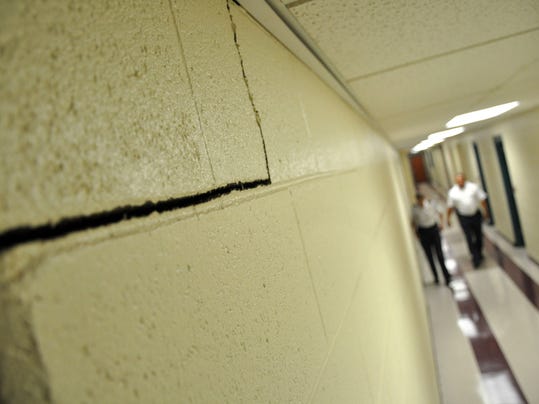Earthquake study may shed light on Delmarva
February 17, 2015

(Photo: Staff photo by Matthew Gunby)
Delmarva might not have much in common with Washington, D.C.
But it does have this: Both are built on a foundation of sediment. Because of that, geologists say, both regions may be more susceptible to earthquake damage.
That's the theory anyway. A U.S. Geological Survey study launched in November aims to help scientists better estimate the strength of future tremors in the Chesapeake Bay region.
USGS researchers partnered with Virginia Tech to install 25 seismometers around the District of Columbia. The bowl-size sensors can detect even minor ground-shaking, a key function in an area that experiences very few strong earthquakes, said Thomas Pratt, the USGS researcher heading the project.
"It should give us an idea whether the results match what we predict," Pratt said.
Researchers focused their work on the nation's capital, in part, because of its dense crop of tall buildings and large population, Pratt said. While the results won't speak directly to Delmarva, they should still speak volumes about how the peninsula might fare in the next earthquake, he added.
The study is part of a tidal wave of geological research in the wake of the 5.8-magnitude earthquake that struck central Virginia.
The rattling could be felt from Georgia to Maine and as far west as Chicago. In the District, 90 miles from the epicenter, the shaking damaged several landmarks, including the Washington Monument and the National Cathedral.
On Delmarva, there was little damage. The most notable: a large crack in a first-floor wall at the Salisbury Police Department.
But the earthquake rattled windows and walls and shifted filing cabinets in Princess Anne and caused computer monitors to swing back and forth at Salisbury University.
USGS scientists tracked the earthquake's strength by asking Internet users to fill out a questionnaire. Some 140,000 responses streamed in, showing that the strongest shockwaves leapfrogged dozens of miles away from the epicenter, said Susan Hough, a USGS seismologist based in Pasadena, California, who analyzed the reporting and wrote about it.
The areas of greatest intensity, shown in shades of red and orange on her map, flocked to the District, southern Maryland and — not as widely felt but of similar strength — in some western portions of the Eastern Shore of Maryland.
"It's that Chesapeake bay region that really lights up," Hough said. "You definitely have the amplification going on in your area."
The destructive waves generated by earthquakes travel in different ways underground, depending in part on the consistency of the soil or rock they encounter, Pratt said. In sediment-laden areas, the shaking is more pronounced, with the back-and-forth movement lengthened (or amplified) four or five times as much compared with bedrock.
"It's like a pan of Jello that you shake and it shakes more," Hough said.
Pratt calls East Coast tremors "low-probably, high-risk" earthquakes. They are few and far between. But unlike California, many of the region's building's and infrastructure simply aren't constructed to withstand violent shaking.
The USGS will continue to monitor the shaking in the District until this summer. Pratt said he hopes the information helps city planners and architects determine how strong they should build new structures.
--
__._,_.___

No comments:
Post a Comment